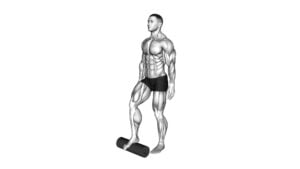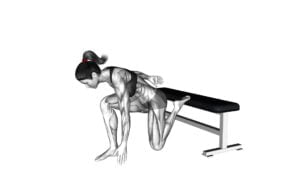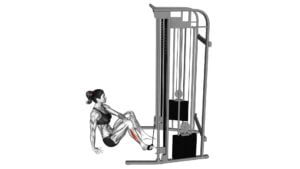Roll Foot (female) – Video Exercise Guide & Tips

Are you looking to improve your foot mobility and strengthen your lower body? Our Roll Foot exercise guide is here to help!
Watch This Exercise Video
In this video guide, you'll learn the proper technique for the Roll Foot exercise, along with variations and modifications for different fitness levels.
Avoid common mistakes and get useful tips on incorporating this exercise into your workout routine.
Let's roll those feet and get stronger together!
Key Takeaways
- The roll foot exercise improves balance, strengthens foot muscles, enhances stability, and prevents falls and injuries.
- Proper technique includes starting in a comfortable standing position, lifting heels off the ground, and rolling feet forward from balls to toes and back from toes to balls.
- Variations and modifications for different fitness levels include performing the exercise seated, using a resistance band or an unstable surface, and seeking guidance from a qualified fitness professional if needed.
- Common mistakes to avoid during the roll foot exercise include neglecting proper alignment and form, rushing through the exercise, relying on support from a wall or chair, and practicing on a soft surface.
Benefits of the Roll Foot Exercise
You will experience several benefits from incorporating the Roll Foot exercise into your fitness routine. This exercise is great for improving balance and strengthening your foot muscles. By regularly performing the Roll Foot exercise, you can enhance your overall stability and prevent falls or injuries.
When you engage in the Roll Foot exercise, you're actively working the muscles in your feet. This helps to strengthen the arches of your feet, which can lead to better balance and stability. Strong foot muscles also provide a solid foundation for your body during various activities, such as walking, running, or playing sports.
Additionally, the Roll Foot exercise can help to improve proprioception, which is your body's ability to sense its position in space. By challenging the small muscles in your feet, you can enhance your proprioceptive abilities and have better control over your movements. This can be especially beneficial for older adults who may experience a decline in balance and coordination.
Incorporating the Roll Foot exercise into your fitness routine is a simple yet effective way to improve balance and strengthen your foot muscles. By dedicating just a few minutes each day to this exercise, you can reap the benefits of increased stability and reduced risk of foot and ankle injuries.
Proper Technique for the Roll Foot Exercise
To perform the Roll Foot exercise correctly, start by positioning yourself in a comfortable standing position. Keep your feet shoulder-width apart and your knees slightly bent.
Begin by lifting your heels off the ground and shifting your weight onto the balls of your feet. Slowly roll your feet forward, from the balls to the toes, while keeping your heels off the ground. Then, roll your feet back, from the toes to the balls, while keeping your toes off the ground. Repeat this rolling motion for the desired number of repetitions.
Proper technique is crucial for maximizing the benefits of the Roll Foot exercise. One common mistake is rushing through the movement, which can lead to instability and reduced effectiveness. It's important to maintain control and perform the exercise in a slow and controlled manner.
Another common mistake isn't fully engaging the muscles of the feet and lower legs. To get the most out of the exercise, focus on actively contracting the muscles as you roll your feet.
The Roll Foot exercise offers several benefits. It strengthens the muscles of the feet, ankles, and lower legs, which can improve balance and stability. Additionally, it can help to alleviate foot and ankle pain, as well as improve flexibility and range of motion in the feet.
Incorporating the Roll Foot exercise into your regular workout routine can contribute to overall foot health and enhance athletic performance.
Variations and Modifications for Different Fitness Levels
As you progress in your fitness journey, you can tailor the Roll Foot exercise to your specific fitness level by incorporating variations and modifications. If you have any injuries or physical limitations, it's important to adapt the Roll Foot exercise accordingly.
For example, if you have a knee injury, you can perform the exercise while seated instead of standing. This will help to reduce the pressure on your knees while still engaging your core and lower body muscles.
To make the Roll Foot exercise more challenging for advanced fitness levels, you can try incorporating some advanced variations. One option is to use a resistance band around your thighs to add extra resistance and engage your muscles even more. Another option is to perform the exercise on an unstable surface, such as a balance board or a foam pad. This will require more stability and core strength to maintain proper form throughout the movement.
Remember to always listen to your body and adjust the exercise as needed. If something feels uncomfortable or painful, it's important to stop and seek guidance from a qualified fitness professional.
Common Mistakes to Avoid During the Roll Foot Exercise
One common mistake to avoid during the Roll Foot exercise is neglecting proper alignment and form. It's important to maintain a straight spine and engage your core muscles throughout the exercise. This will help prevent any strain on your lower back and ensure that you're targeting the correct muscles.
Another mistake to avoid is rushing through the exercise. Take your time and focus on each movement, paying attention to the placement of your feet and the rolling motion. This will help you improve your balance and stability.
To modify the Roll Foot exercise, you can use a wall or a chair for support. Start by standing next to the wall or holding onto the back of the chair for balance. As you become more comfortable, you can gradually reduce the amount of support you use. Additionally, you can try practicing the exercise on a soft surface, such as a yoga mat or carpet, to provide some cushioning and make it easier on your feet.
Improving your balance in the Roll Foot exercise can be achieved by incorporating other balance exercises into your routine. Exercises like single-leg stands and heel-to-toe walks can help strengthen the muscles involved in maintaining balance. Additionally, practicing yoga or Pilates can also improve your overall stability and coordination.
In the next section, we'll provide tips for incorporating the Roll Foot exercise into your workout routine. By following these tips, you can maximize the benefits of this exercise and enhance your overall fitness level.
Tips for Incorporating the Roll Foot Exercise Into Your Workout Routine
Start by incorporating the Roll Foot exercise into your workout routine by focusing on proper technique and gradually increasing the intensity. The Roll Foot exercise is a great way to strengthen your feet, ankles, and lower legs, and can be easily incorporated into your existing workout routine.
To begin, find a comfortable place to sit or stand, and place a small towel or ball under your foot. Roll your foot back and forth over the towel or ball, applying gentle pressure. As you become more comfortable with the exercise, you can increase the pressure and duration of the roll.
This exercise can be done before or after your regular workout, or even during breaks throughout the day. The benefits of incorporating the Roll Foot exercise into your routine include improved balance, increased ankle stability, and enhanced foot and ankle strength. Additionally, this exercise can help prevent injuries, such as sprains and strains, by strengthening the muscles and tendons in your feet and ankles.
Frequently Asked Questions
Can the Roll Foot Exercise Help With Plantar Fasciitis?
The roll foot exercise can help relieve plantar fasciitis pain. By rolling your foot on a small ball or foam roller, you can stretch and massage the plantar fascia, promoting healing and reducing inflammation.
Consistency is key, so make sure to incorporate this exercise into your daily routine. Results may vary, but many people start to see improvements within a few weeks of regular practice.
Remember to consult with a healthcare professional before starting any new exercise program.
How Many Reps and Sets Should I Do for the Roll Foot Exercise?
To get the most out of the roll foot exercise, it's important to know how many reps and sets to do. By performing multiple reps and sets, you can effectively strengthen your foot muscles and improve flexibility.
The number of reps and sets can vary depending on your fitness level and goals. It's generally recommended to start with 2-3 sets of 10-15 reps and gradually increase as you get stronger.
This exercise can provide numerous benefits, including improved balance, stability, and prevention of foot injuries.
Is It Safe to Do the Roll Foot Exercise if I Have a History of Ankle Injuries?
If you have a history of ankle injuries, it's important to consider the safety of the roll foot exercise. Ankle injuries can make this exercise risky, as it involves rolling the foot.
Instead, focus on alternative ankle exercises that can strengthen the muscles without putting too much strain on the injured area.
Additionally, if you still want to try the roll foot exercise, make sure to take precautions and modify it to suit your needs.
Can the Roll Foot Exercise Help Improve Balance and Stability?
The roll foot exercise can be beneficial for improving balance and stability. By incorporating this exercise into your routine, you can strengthen the muscles in your feet and ankles, which can help enhance your overall stability.
To perform the roll foot exercise, start by standing with your feet hip-width apart. Then, roll your foot from the outside to the inside, shifting your weight onto the outer edge of your foot. Repeat on the other side.
Are There Any Specific Footwear Recommendations for Performing the Roll Foot Exercise?
For the roll foot exercise, it's important to have specific footwear recommendations. Wearing shoes with good arch support and a stable sole can help you maintain balance and prevent injuries.
The roll foot exercise itself is beneficial for improving your balance and stability. By rolling your foot from the heel to the ball and toes, you engage the muscles in your feet and lower legs, helping to strengthen and stabilize them.
Conclusion
Incorporating the roll foot exercise into your workout routine can bring numerous benefits.
This exercise helps improve balance, flexibility, and strength in the feet and ankles.
By following the proper technique and avoiding common mistakes, you can maximize the effectiveness of this exercise.
Additionally, there are variations and modifications available to suit different fitness levels.
So, whether you're a beginner or advanced, the roll foot exercise is a great addition to any fitness regimen.
Start rolling your way to stronger and more agile feet today!

Author
Years ago, the spark of my life’s passion ignited in my mind the moment I stepped into the local gym for the first time. The inaugural bead of perspiration, the initial endeavor, the very first surge of endorphins, and a sense of pride that washed over me post-workout marked the beginning of my deep-seated interest in strength sports, fitness, and sports nutrition. This very curiosity blossomed rapidly into a profound fascination, propelling me to earn a Master’s degree in Physical Education from the Academy of Physical Education in Krakow, followed by a Sports Manager diploma from the Jagiellonian University. My journey of growth led me to gain more specialized qualifications, such as being a certified personal trainer with a focus on sports dietetics, a lifeguard, and an instructor for wellness and corrective gymnastics. Theoretical knowledge paired seamlessly with practical experience, reinforcing my belief that the transformation of individuals under my guidance was also a reflection of my personal growth. This belief holds true even today. Each day, I strive to push the boundaries and explore new realms. These realms gently elevate me to greater heights. The unique combination of passion for my field and the continuous quest for growth fuels my drive to break new ground.



